In between scheduled flights, I found a Propair employee. I asked him all of one question: “Can I take a look around the Gulfstream?”
His answer, as far as I could tell, was yes.
In between scheduled flights, I found a Propair employee. I asked him all of one question: “Can I take a look around the Gulfstream?”
His answer, as far as I could tell, was yes.
Story & Photos by Jeremy Dwyer-Lindgren ’“ A joint venture between Airchive & AirlineReporter.com
This is part two of the journey on LOT Polish’s new Boeing 787 Dreamliners. Part one, in premium economy, is available here.
After four days well spent touring Poland it was time to come home. While our initial trip was in LOT’s new premium economy, dubbed Premium Club, our return would be in Elite Club, or business class. Having started the trek back to New York from the southern Polish city of Krakow, we arrived to the domestic wing of Warsaw’s Chopin Airport and headed for the lounge.
LOT’s premium lounge is centrally located after security, above the main floor, but before passport control. The wooden decor mixed with lots of greenery made for a pleasing, comfortable aesthetic. Seating areas, split into smaller sections, boasted cozy chairs and coat racks. A selection of hot and cold food along with a generous selection of drinks could be found at several locations. The space was generally well stocked and clean. Unfortunately it was extremely crowded during our visit, and thus our stay was quite short.
Back in the terminal we made our way through passport control and to a second post-passport-control lounge. It was not a LOT lounge, but rather a private non-airline lounge that served any premium passengers at the airport. While not quite as nice or as well apportioned as LOT’s, it was arguably larger and (most importantly) far less crowded.
Boarding followed a thirty minute delay, and Elite Club passengers utilized a separate gateway to the forward-most door. Being one of the last to board we were surprised to see the business class cabin virtually empty, with well under half the cabin filled. Bags easily found a home in the overhead bins, though it would not have been an issue if the cabin were full either. Not long after taking our seat in 2F friendly flight attendants came by offering us a selection of preflight drinks and newspapers. Following a smooth departure our aircraft climbed steadily over Warsaw and headed west towards the Atlantic coast.
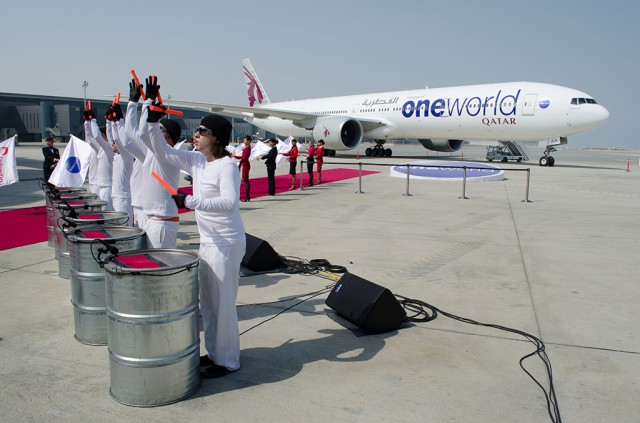
A Ceremony in Doha, Qatar to celebrate the joining of Qatar Airways to the oneworld Alliance – Photo: Airchive.com
At midnight local time in Doha on the 30th of October (5pm EST/2pm PST on the 29th of October) Qatar Airways became the newest member of the oneworld Alliance. The joining of Qatar sees the oneworld Alliance strengthen its position in the middle east and also welcomes the fastest integration of an airline into the alliance in its history.
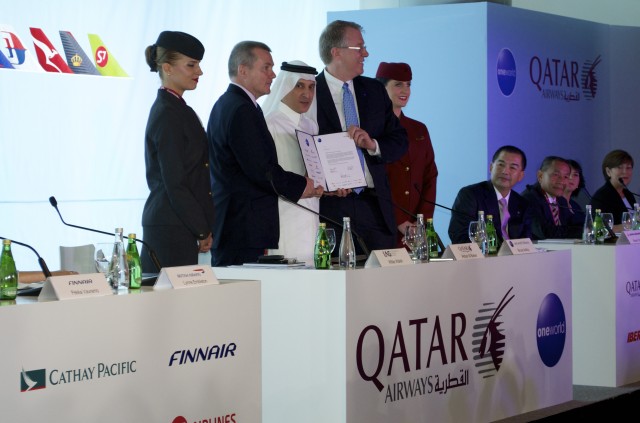
Qatar Airway CEO Akbar Al Baker signs the airline into the oneworld Alliance in Doha – Photo: Airchive.com
At a ceremony at the new Hamad Airport (previously referred to as the New Doha International Airport) Qatar was joined by other oneworld member airlines for the traditional document signing, thus signaling the official joining of Qatar Airways to the alliance. Qatar Airways’ Chief Executive Akbar Al Baker said: ’œAlliances are playing an increasingly important role in the airline industry today ’“ and that will continue long into the future. Becoming a member of oneworld is one of the most significant landmarks in Qatar Airways’ history. It will strengthen our competitive offering and give our customers what they fully deserve ’“ more choice across a truly global network served together with airline partners who include some of the best and biggest in the world.”
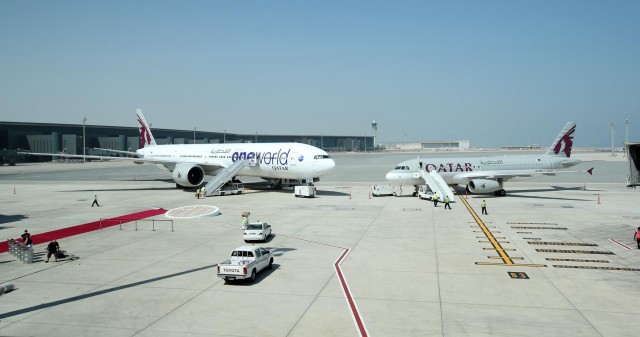
The oneworld-liveried Qatar 777 parked at Hamad International Airport prior to the oneworld signing ceremony – Photo: Qatar Airways
After the signing, flight attendants from all member airlines lined a red carpet for the reveal of the newest oneworld-liveried aircraft. A Boeing 777-300ER (A7-BAA) was flown directly into New Hamad Airport, being the first Qatar Airways aircraft to land and park at this yet-to-be-opened airport (expected in 2014). Resplendent in the oneworld livery, the aircraft was joined by members of the media, guests, and the Prime Minister of Qatar.
The first flights to depart after midnight (QR1166 from Doha to Riyadh, Saudi Arabia & QR633 from Dhaka, Senegal to Doha) saw the real beginning of the membership, as passengers could receive reciprocal benefits from other oneworld members & experience program link benefits as well. As oneworld Chief Executive Bruce Ashby stated, ’œoneworld aims to be the first choice alliance for the world’s frequent international travellers ’“ with an unrivalled collection of quality carriers, delivering unmatched benefits to customers and to member airlines alike. Qatar Airways’ addition as our second member airline in the middle east makes oneworld the leading alliance in what is one of the world’s fastest growing regions for air travel demand. When Qatar signed the documents to join the alliance, they became the strongest of the 3 global alliances in the middle east. Utilizing the Doha hub, oneworld now has an extensive new middle east network that rivals any other major power.”
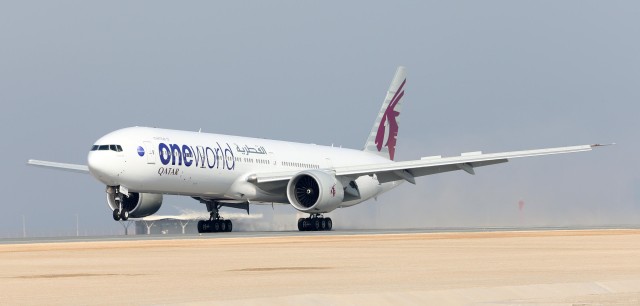
The oneworld-liveried 777-300ER from Qatar Airways touches down at Hamad International Airport in Doha – Photo: Qatar Airways
As the oneworld carriers celebrate the join by releasing a double miles promotion for the next two months (almost a tradition, as the same was run for Air Berlin when they joined), a few of the other benefits of the new membership come into effect. Have you got American AAdvantage miles to burn? Well you can use them to get to places like Kilaminjaro or The Maldives easier. But one small piece of information has disappointed top-tier elite frequent fliers. Oneworld Emerald members should receive First Class lounge access, and with Qatar’s amazing Premium Terminal, some were foaming at the mouth in anticipation of accessing this amazing facility. However, it is not to be, as Qatar Airways is instituting a policy similar to British Airways, whereas only those flying Qatar Airways im premium classes (First & Business) will be able to access the Premium Terminal; all economy guests holding relevant status will get lounge access still, but in a different lounge (similar to the BA Concorde Room policy, where only those flying British Airways First Class have access).
As 2013 comes to a close, we look to next year and oneworld is set to get stronger again, as the alliance is preparing to welcome more airlines into fold. Sri Lankan Airlines has been confirmed to join in April 2014; TAM should join as well after leaving the Star Alliance to align themselves with sister airline LAN. Also US Airways should hopefully join as they merge with American (if all goes well, that is, but that is another story). Is Qatar’s joining of Oneworld a sign of things to come? As the first of the major middle east carriers to join an alliance, will others follow, or is this just Qatar’s way of competing against the other carriers? Time will tell.
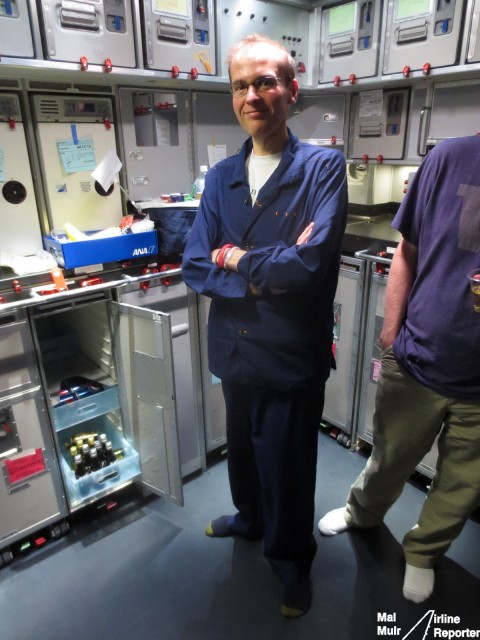
Me sporting ANA Business Class pajamas, which unfortunately you have to give back at the end of the flight. They are super comfy! – Photo: Mal Muir | AirlineReporter.com
Recently you’ve heard often from airlines that they are cutting first class products and services from their aircraft, but that still leaves many with a competitive business class cabin. When people say that ’œbusiness class is the new first class,” the statement is becoming more truthful each day. Lie-flat seats, designer amenity kits, and multi-course meals are now as common in business class as they are (or were) in first. But one small item is slowly making an emergence in business class, one that has always been thought of solely as a first class staple: airline pajamas.
Airline pajamas have, up until now, been given out to those flying first class on international airlines like Singapore, Lufthansa, Thai, or Emirates. They’re provided to the passenger so that they can relax while onboard without having to wrinkle their own clothes, or to allow them to get that full night’s sleep more comfortably.
But times are changing; as airlines roll back those first class cabins, passengers who fly in business class expect the same level of service and amenities. So airlines like Qatar Airways, Qantas, Virgin Atlantic, and All Nippon Airways (ANA) are now providing pajamas to passengers in the business class cabin. But are these pajamas as good as the first class offerings out there?
Lines. Queues. Waiting. Standing around. Wasting time. These are the things any frequent traveler goes out of their way to avoid. No passenger wants to see a 45 minute line full of clueless people in front of them, separating them from the safety of the airline lounge. On return from a trip abroad, the line for customs and immigration can be even worse, lasting for hours.
Global Entry and TSA Pre Check, two separate but cooperating programs, have set out to eliminate long lines for frequent flyers. These programs, however, are not available to everyone. There are multiple ways to join each program, so lets take a look at who is eligible for what, and how they can apply.